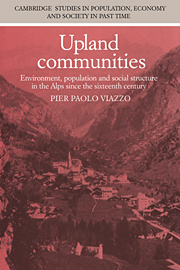 Upland Communities
Upland Communities Book contents
- Frontmatter
- Contents
- List of illustrations
- List of tables
- List of abbreviations
- Acknowledgements
- Introduction: anthropology, historical demography and the study of mountain societies
- 1 Environment, population and social structure: the Alpine village as an ecosystem
- 2 Open systems, open questions
- 3 Anthropologists in the Alps
- 4 The changing demography of Alpine communities
- 5 The traditional economy and its demise
- 6 The causes and consequences of Alpine emigration
- 7 The wealth from the earth: mining and immigration
- 8 Population, resources and homeostatic regulation
- 9 The domestic domain
- 10 Upland communities
- A summary of conclusions
- Bibliography
- Index
1 - Environment, population and social structure: the Alpine village as an ecosystem
Published online by Cambridge University Press: 13 October 2009
- Frontmatter
- Contents
- List of illustrations
- List of tables
- List of abbreviations
- Acknowledgements
- Introduction: anthropology, historical demography and the study of mountain societies
- 1 Environment, population and social structure: the Alpine village as an ecosystem
- 2 Open systems, open questions
- 3 Anthropologists in the Alps
- 4 The changing demography of Alpine communities
- 5 The traditional economy and its demise
- 6 The causes and consequences of Alpine emigration
- 7 The wealth from the earth: mining and immigration
- 8 Population, resources and homeostatic regulation
- 9 The domestic domain
- 10 Upland communities
- A summary of conclusions
- Bibliography
- Index
Summary
Universals in mountain habitats
When Lucien Febvre wrote, in 1922, that ‘il n'y a point une sorte d'unite de la montagne’, he was reacting against those followers of Ratzel who stressed the similarities found in the social and economic life of upland populations in order to demonstrate that analogous geographical conditions always entail analogous developments. If too strong an emphasis is placed on general similarities, he rightly argued, the various mountain areas are inevitably stripped of their distinctive history. Yet neither Febvre nor Vidal de la'Blache, the forerunner of geographical possibilism, would deny that in the mountains the impact of the natural environment on human populations is most dramatic and direct, especially in the high valleys. Nor would they dispute that mountain habitats are universally characterized by a certain number of major physical and climatic features.
The outstanding feature of any mountain habitat is of course altitude, which powerfully affects such climatic factors as air pressure and composition, insolation, winds, evaporation, humidity, precipitation, and above all temperature. It is well known that with the rise from the sea level into the upper regions of the atmosphere the temperature decreases. It was been calculated, for instance, that on the northern side of the Swiss Alps the mean annual temperature drops from about 8.5 C at 500m of altitude to 5.4 C at 1,100 m and to 0.3 C at 2,000 m.
- Type
- Chapter
- Information
- Upland CommunitiesEnvironment, Population and Social Structure in the Alps since the Sixteenth Century, pp. 16 - 30Publisher: Cambridge University PressPrint publication year: 1989
